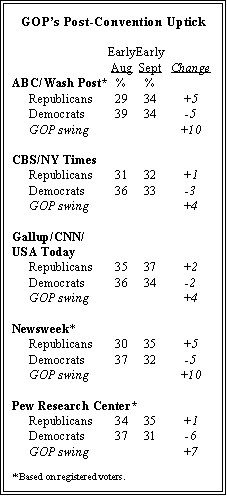
During every presidential election, questions arise over the results of political polls and how those surveys are conducted. This year’s hot topic is the partisan composition of the leading national polls. Politicians and pundits alike now scrutinize a survey sample’s partisan split as closely as the horse-race results. Surveys that are deemed to have “too many” Republican or Democratic respondents are widely viewed as biased in favor of George Bush or John Kerry.
These assertions reflect fundamental misunderstanding of party affiliation and how it is measured by polling organizations. Party affiliation is derived from a question typically found at the end of a survey questionnaire, in which respondents are asked how they regard themselves in politics at the moment. In Pew Research Center surveys, the question asks: “In politics today, do you consider yourself a Republican, Democrat or Independent?”
This question is not intended to measure how respondents are registered, how they have voted in the past, or how they have thought of themselves throughout most of their lives. Like most other questions on public opinion surveys, it is intended to measure current feelings about politics in this case, their feelings of affiliation or disaffection with the major political parties.
Given that it is an attitude and not a personal characteristic, it is not at all comparable to race, ethnicity, gender, age, education, or other demographic markers that are routinely used to check on the representativeness of surveys. Further, long-term tracking and analysis of party identification finds that, for a number of reasons, it varies a good deal from survey to survey.
Party identification is not a particularly stable attitude many people go back and forth on how they regard themselves. When respondents are surveyed and then re-interviewed at a later date, substantial minorities give different answers. In November 2000, after the presidential election, Pew re-interviewed 1,113 voters who had participated in a survey in September of that year. In the period between the surveys, 18% of voters answered the party affiliation question differently than they had just two months earlier. And not much time needs to pass in order to see this sort of instability. In the 1988 post-election study, voters were called back less than three weeks after the initial contact, and fully 16% changed party labels in that time.
Second, party affiliation can and often does vary in response to major events. Surveys by the Gallup Organization since the beginning of last year show considerable fluctuation from poll to poll in party affiliation. There is no clear pattern in many of these changes, but Republicans made a decided, though short-lived, gain in party affiliation in December 2003, following the capture of Saddam Hussein. By early January, the partisan composition of Gallup’s sample had returned to about the same proportions as in early December (see chart, pg. 3). There also are indications that the percentage identifying with the GOP declined last spring, as the situation in Iraq worsened, but recovered somewhat over the summer.

While many of the bumps and bounces in party identification are short-lived responses to events, there also are longer term trends that reflect broader changes in public sentiment. For example, Pew’s analysis of party identification trends for the period September 2001-October 2003 found that the Republicans had erased the Democrats’ long-term advantage in party affiliation.
However, by the middle of this year, the Democrats had once again gained a slight edge in partisan identification (based on Pew polls conducted between January and July), again highlighting the inherent fluidity of this measure. A similar pattern was evident in 1994, after the GOP gained control of Congress for the first time in four decades. After the Republicans’ mid-term victory, the percentage of people whoe identified with the GOP rose steadily in the early months of 1995. But the trend came to a fairly abrupt halt in the fall of that year, as the Newt Gingrich-led Congress fell from public favor with the government shutdown.

The responsiveness of partisanship in the current political environment can also be seen across multiple national surveys conducted over the past month. In early August, on the heels of the Democratic convention in Boston, more voters identified themselves as Democrats than Republicans in five major national polls (see chart). However, a month later, in the wake of the Republican convention, each of these polls registered a net shift toward the GOP in partisan identification.
The consistency of the movement across each of these major surveys in this time period suggests that partisanship was not a constant factor this summer, and any efforts to “fix” the partisan balance would be misreading the flow of public opinion.
Partisan identification is a useful concept and a valuable tool for political analysis. However, it is not a hard-and-fast personal characteristic that can be used to judge the representativeness of surveys. Adhering to a preconceived notion of partisan distribution can result in underestimating important shifts in voter sentiment.